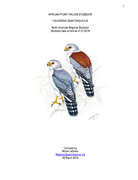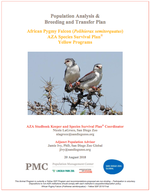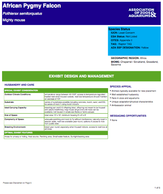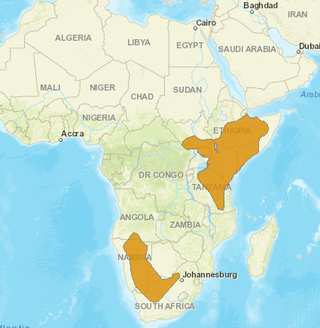-
Natural History
-
SSP
-
Organizations
<
>
Introduction: The African pygmy falcon (Polihierax semitorquatus) is a small raptor found in northeast and southwest Africa. The species is one of the few bird species that are “obligate nest pirates”, primarily occupying the nests of social weavers and white-headed buffalo weavers. In captivity, African pygmy falcons are a popular education species.
Physical Characteristics
The male African pygmy falcon is grey above with a white rump and white below. He has a whitish collar on his hind neck. His tail and flight feathers are black with white spots and bars. His bill is yellow, darker at the tip, and his feet are orange-yellow. The female is identical to the male, but has a large chestnut patch on the back. The juvenile African pygmy falcon is grey above and buff tinted below (Mackworth-Praed and Grant, 1969). Sexes can be differentiated at one month (Maclean, 1970). Wingspan averages 37cm, weight 54 to 67 grams, and torso 20cm (del Hoyo, et al., 1994).
The male African pygmy falcon is grey above with a white rump and white below. He has a whitish collar on his hind neck. His tail and flight feathers are black with white spots and bars. His bill is yellow, darker at the tip, and his feet are orange-yellow. The female is identical to the male, but has a large chestnut patch on the back. The juvenile African pygmy falcon is grey above and buff tinted below (Mackworth-Praed and Grant, 1969). Sexes can be differentiated at one month (Maclean, 1970). Wingspan averages 37cm, weight 54 to 67 grams, and torso 20cm (del Hoyo, et al., 1994).
|
Taxonomy & Range
African pygmy falcons are sometimes considered to be geographically divided into two subspecies: Polihierax semitorquatus semitorquatus and Polihierax semitorquatus castanotus (some times seen as castanonotus). The former is found in western South Africa and the latter in East Africa (Maclean, 1970). The African pygmy falcon population in North America is descended from birds captured in Tanzania, Somalia, and Namibia. The captive population is thus considered P.s. castanotus. Listed as CITES II, African pygmy falcons are not globally threatened. They are widespread and common in most areas (del Hoyo, et al., 1994). Pygmy falcons are not known to migrate and their range is determined by the availability of weaver nests to roost in. |
Conservation
IUCN Red List – Least Concern; USFWS – not listed; CITES – Appendix II
IUCN Red List – Least Concern; USFWS – not listed; CITES – Appendix II
History of Captive Population
The first record of African pygmy falcons in North American was in 1927 at the Bronx Zoo in New York. During this time five birds were brought into captivity from Africa. These birds produced no living offspring. Between 1964 and 1967 seven birds were again brought from Africa to the Bronx Zoo. These birds also failed to produce offspring. In 1985 Dr. Clayton White of Brigham Young University brought five birds to the San Diego Zoo in California. The San Diego Zoo as well as zoos in Fort Worth and Seattle received thirteen more birds from Africa via private collectors. Seven of these birds are the founders of the entire African pygmy falcon population in North America. The first successful captive hatch in North America was in 1988 at the San Diego Zoo’s Safari Park.
The first record of African pygmy falcons in North American was in 1927 at the Bronx Zoo in New York. During this time five birds were brought into captivity from Africa. These birds produced no living offspring. Between 1964 and 1967 seven birds were again brought from Africa to the Bronx Zoo. These birds also failed to produce offspring. In 1985 Dr. Clayton White of Brigham Young University brought five birds to the San Diego Zoo in California. The San Diego Zoo as well as zoos in Fort Worth and Seattle received thirteen more birds from Africa via private collectors. Seven of these birds are the founders of the entire African pygmy falcon population in North America. The first successful captive hatch in North America was in 1988 at the San Diego Zoo’s Safari Park.
Sources Cited:
1. Maclean, G. L. (1970). The Pygmy Flacon Polihierax Semitorquatus. Koedoe, 13, 1-21.
2. Brown, Leslie and Dean Amadon. (1989). Eagle, Hawks and Falcons of the World (Volume 1). Secaucus, NJ: The Wellfleet Press.
3. Kemp, Alan. (1980). The Birds of Prey of Southern Africa. Johannesburg, South Africa:Winchester Press.
4. Ginn, P.J. and W.G.McIlleron and P. le S. Milstein. (1990). The complete Book of Southern African Birds. Foreshore, Capetown: Struik Winchester.
5. Del Hoyo, J. and A. Elliott and J. Sargatal. (1994). Handbook of Birds of the World (Volume 2). Barcelona, Spain: Lynx Edicions.
6. Steyn, Peter. (1983). Birds of Prey of Southern Africa; Their identification and life histories. Dover, New Hampshire: Tanager Books.
7. Spottiswoode, Claire and Percy Fitzpatrick and Eric Herrmann and O Anne R Rasa and Colin W Sapsford. (2004). Co-operative Breeding in the Pygmy Falcon Polihierax semitorquatus. Ostrich, 75 (4), 322-324.
1. Maclean, G. L. (1970). The Pygmy Flacon Polihierax Semitorquatus. Koedoe, 13, 1-21.
2. Brown, Leslie and Dean Amadon. (1989). Eagle, Hawks and Falcons of the World (Volume 1). Secaucus, NJ: The Wellfleet Press.
3. Kemp, Alan. (1980). The Birds of Prey of Southern Africa. Johannesburg, South Africa:Winchester Press.
4. Ginn, P.J. and W.G.McIlleron and P. le S. Milstein. (1990). The complete Book of Southern African Birds. Foreshore, Capetown: Struik Winchester.
5. Del Hoyo, J. and A. Elliott and J. Sargatal. (1994). Handbook of Birds of the World (Volume 2). Barcelona, Spain: Lynx Edicions.
6. Steyn, Peter. (1983). Birds of Prey of Southern Africa; Their identification and life histories. Dover, New Hampshire: Tanager Books.
7. Spottiswoode, Claire and Percy Fitzpatrick and Eric Herrmann and O Anne R Rasa and Colin W Sapsford. (2004). Co-operative Breeding in the Pygmy Falcon Polihierax semitorquatus. Ostrich, 75 (4), 322-324.
|
Date of Last PVA/B&T Plan
8/2018 Current Population Size (N) 52 (26.24.2) Current Number of Participating AZA Member Institutions 17 Projected % GD at 100 years or 10 generations** 56% |
|

|

Population Analysis & Breeding and Transfer Plan
African Pygmy Falcon (Polihierax semitorquatus) AZA Species Survival Plan® Yellow Program |

Sustainability Report
African Pygmy Falcon (Polihierax semitorquatus)
AZA Species Survival Plan® Yellow Program
African Pygmy Falcon (Polihierax semitorquatus)
AZA Species Survival Plan® Yellow Program
Officers
|
Name
|
Organization
|
Position
|
|
San Diego Zoo
|
SSP Program Leader & Studbook
|
|
Brandywine Zoo
|
Education Advisor
|


